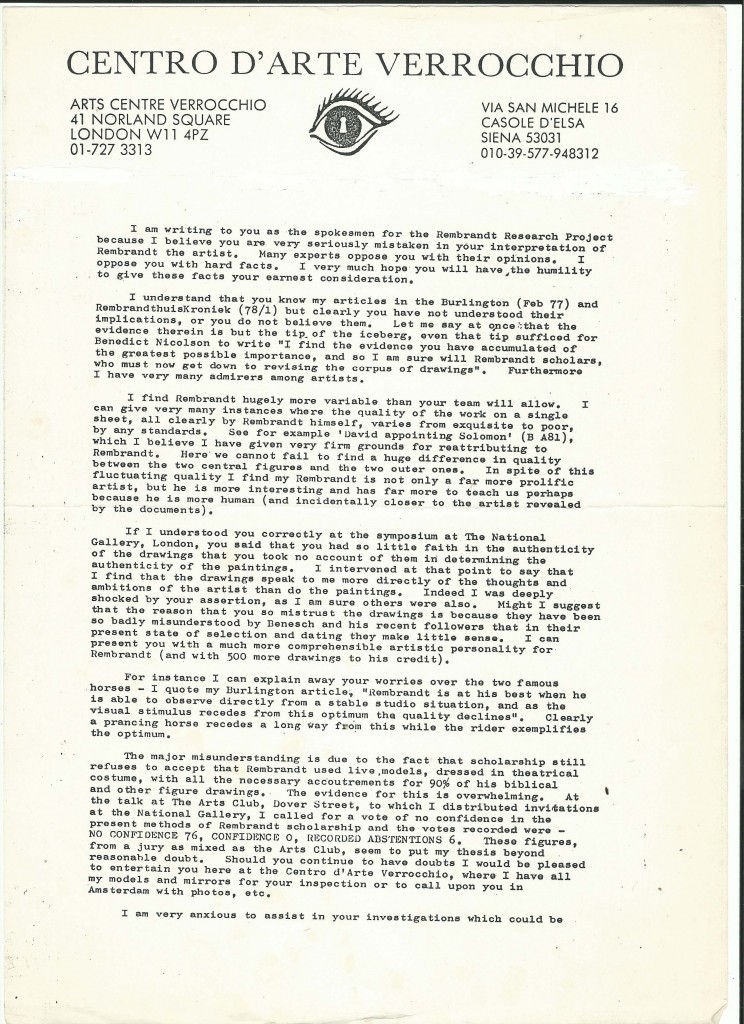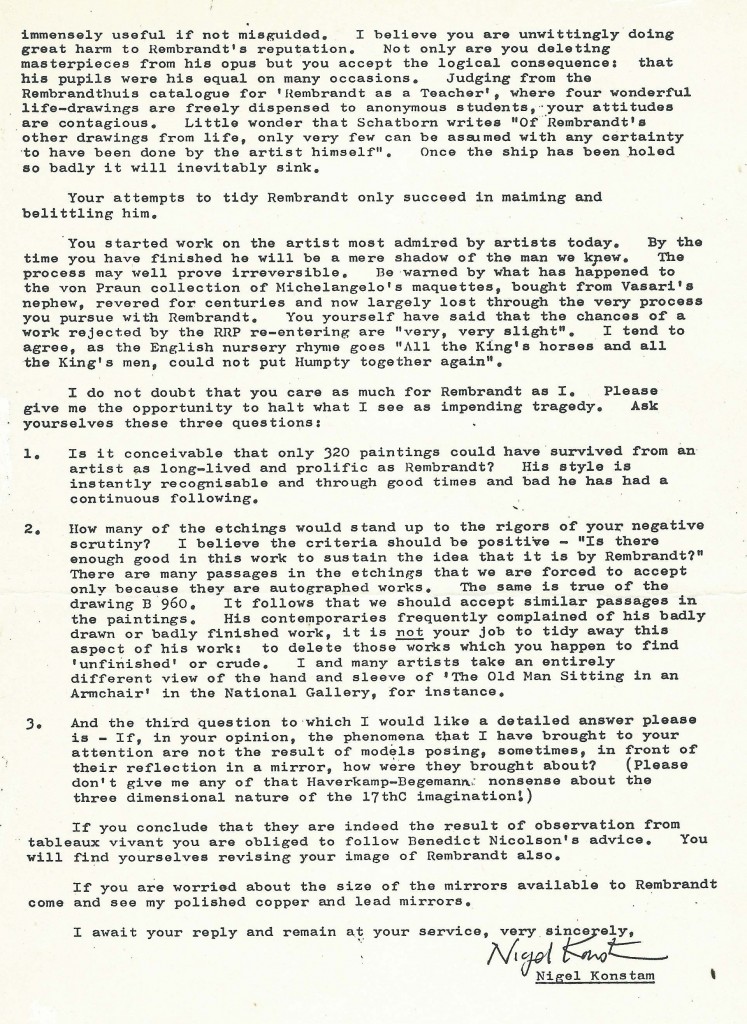At 81 my dream of being able to restore Rembrandt to his true status is fading. I have done all I can to inform a new generation of how to go about it in my book and on YouTube. What I have been unable to achieve is the training of fresh minds and eyes to see Rembrandt as I see him. Though I have advertised courses at the Centro d’Arte Verrocchio no one has enroled. However, I feel my ship is coming home and the offer of training still stands.
There have been a number of unacknowledged victories over the years and two major ones just recently: The National Gallery has reinstated their Adoration of the Shepherds, dismissed by the RRP. Second, Van der Wetering, once leader of the RRP has welcomed back the National Gallery’s Old Man Sitting in a Chair as “a very important painting”. I vigorously opposed its deattribution at the time. I feel sure that my YouTube demonstration of “The Adoration” must have convinced someone with clout at the NG. It is still not reattributed by the RRP as far as I know.
I was the first to condemn Isaac Joudeville as a contender to have painted early Rembrandt portraits. Christopher Brown followed my lead and Joudeville has not been heard of since. (Johannes Raven has taken his place with even less to recommend him as a draughtsman.) I also insisted that Rembrandt’s Wallace self-portrait, nasty as it is, was still genuine. All of which are now accepted as true. We are just waiting for the landslide of 1000 Rembrandt drawings to return to the fold. This must happen when the scholars recognize that his contemporaries knew what they were talking about when they said such things as “ he would not attempt a single brush-stroke without a living model before his eyes” (A.Houbraken)
Here is further advice to the new generation
1. Be very skeptical of the old guard in every respect.
2. Try to get the cooperation of Scotland Yard (or similar) to check ink, paper and handwriting. (A list of instances will follow.)
3. Get an artist admirer of Rembrandt to teach you drawing every day till satisfied that you have got the point. Then once a weak, at least.
4. Study my film on Hadrian and the influence of Roman portraiture on Rembrandt and many others.
5. Study my criticism of Raphael.
6. Expect from Rembrandt observations of life as it is, definitely not idealized.
7. Beware of hubris and rigidity. Rembrandt is very varied, perhaps bipolar.
There is nothing wrong with experiment in art. We have evolved through an infinite number of experiments over a period of millions of years. It is nature’s way – natural selection must occur through the survival of the fittest. What is terribly wrong with our visual culture is the unnatural human selection that has been left in the hands of incompetent experts over the last 100 years: their background is usually literary rather than visual. They have been proved wrong so many times that they have become expert in little else but cover-up. (see www.nigelkonstam.com for a series of uncorrected fallacies in art history)
Artists are told to express their own era in art but there are many artists who intensely dislike the direction of our establishment culture today. We despise its values and art is first and foremost about values – human values. We express our own values which are also contemporary, in the hope that they will eventually be found more valuable than the values thrust down our throats by the “experts” and their allies in the mass-media.
We dissidents (“the wrong kind of artist” according to Sir Nicolas, our dictator) believe it our duty to oppose the establishment in the hope of achieving a change of heart. This has happened regularly in art before. The Impressionists in retrospect, are now seen as the avant-guard instead of the decadent lunies they were considered in their own day.
Many heroes of art tend to have been regarded as lunatics in their time. Our establishment have taken this to heart and promote lunacy wherever they find it. This has proved an unwise policy yet they persist. Readers of the Jackdaw will have no difficulty in seeing why the establishment policy has remained so narrow and stagnant for so long. The President for Life ensures a good living for his friends through government patronage, prizes and promotion. General promotion naturally follows this forceful lead, so the favoured few receive all that is available for the arts. The majority of artists (probably more than 90%) are not heard or seen in public. The lime-light of official backing is too powerful for any private initiative to break through their barrage of sound bites and prestigious exhibitions.
Certainly there have been artists who have gone mad: Van Gogh and Schumann spring to mind. In our own day so many pop musicians have gone off the rails there can be little doubt that the profession ‘artist’ is an unsettling one. Establishment critics need to find some better criteria. May I suggest a way forward.
Human knowledge tends to move forward building on past experience. Science normally progresses as a result of critical reviewing of past ideas. The same was true of the arts: Poets tend to read past poets and are influenced by what strikes them as apt for our own times. The visual arts used to move forward in the same way but have been recently diverted from this time-honour process by the experts’ desperate attempts to identify the ‘avant-guard’. Sadly, the history of these attempts does not give grounds for optimism. Genuine advance normally emerges in public consciousness well after the event. The long string of pseudo avant-guards that have emerged since WWII, lauded by critics and the mass-media should be subject to regular review. An annual show of The Tate Gallery purchases of the 60’s, 70s etc would certainly amuse thirty years later and might even give a necessary boost to the humility of the present generation of experts.
One of the main tragedies of our present culture is we rely too heavily on expert advice; even when it looks crazy. The extraordinary diversity of art in our time would be much better served if government patronage was handed in turn to a different school of artistic thought every two or three years. Leaving it up to the leaders of each school to decide how to distribute the prizes and which works of art to purchase for public collections. This would circumvent the mono-culture of the experts we are saddled with at present; it would give the interested public the possibility of enjoying the wide panorama of art that exists today but remains largely unseen.
It would save a great deal of government money if the arts administrators were replaced by part-time artist administrators, elected by each school, who would look after the interests of their school. The rivalry of the different schools would be stimulating. My guess is that better informed critics would soon emerge allied to each particular school who would make a lot more sense than our alienating “artbollocks”. Genuine public interest would be restored, which would draw back private patronage to augment and guide a new era of government spending. Sadly, The Arts Council has gone horribly wrong.
The American tax system of encouraging private patronage and perhaps 40 years later accepting prize works of art for museums (as a part of inheritance tax) is so much more sensible and democratic than our system. It gives the necessary spread of patronage and time for genuine evaluation. The wild extravagance of UK government purchases may have successfully swung the world market behind them. But leading a culture of pure greed should not be a source of pride. The world market is the least civilized ever; high rewards for nonsense has undermined morale and education in art.
We should encourage diversity; diversity is necessary for evolution. No expert can be expected to predict what will survive in art but they have certainly demonstrated their ability to knock art off course!
There is still plenty of figurative art being done today but we never see or hear of it in the media. It has been eclipsed perhaps because no one writing about art now has the experience to look at it and make sensible judgments about it. As observation has been the main stay of art for the previous 40,000 years we are clearly living through a long hiccup in a major and important field of human activity. Why?
As a student I subscribed to the growing interest in abstraction. Art seemed to be returning to an area that had fallen into neglect in the late 19thC. Brancusi and Picasso seemed to be reconnecting with an element in primitive art that demonstrates the abstract nature of thought resulting from the triumph of word and number. Human knowledge is transmissible and can therefore develop through time as a result of these abstract systems. That said, art is one of the few areas where we can confront and compare nature with what we think we see; we are often surprised. I see observed art as constructing bridges between the abstract nature of our minds and the complexities of the outside world.
The study of primitive and child art can teach us a lot about the way the mind twists the evidence. The advanced study of drawing used to recommend a number of ways in which we could learn to correct some of the loss that inevitably results from abstraction. Now alas, we have the situation where abstract art is matched with nothing. It is beyond criticism, in a world of its own. Our response to the outside world is visibly deteriorating as a result; particularly in the field of response to our fellow humans. Body-language is often misread which was once reliable and instinctive. This developing loss of touch with reality could endanger our survival as a species. (The catastrophe of Rembrandt scholarship over the last 50 years in de-attributing half his genuine works is a forceful reminder of our loss.)
This brings me to the point where I must attempt an answer to my initial question. The change in the course of art coincides with the rise of art history as a deciding power in art. Previously an artist’s fame was influenced by their standing with their peers, now it is decided by the mass-media directed by art experts who paradoxically know little of what has driven artists in the past. A paradoxical result of introducing professional art historians into British art schools is that a noble history of Man’s endeavor over 40,000 years has been cut down to the last 50. So recent students no longer feel that brotherhood of artists: that conversation with the past that frequently leads to genuine originality.
This essay was triggered by chancing upon a book on drawing “ Studien zur Gestalt des Menschen” (Urania 2005) by Gotfried Bammes. He reproduces splendid drawings by his students on various courses in the German speaking world. Such a book would be near impossible in the English speaking world, we are far too individualistic, aiming at novelty rather than that long established quality that we find here. Congratulations Herr Bammes for keeping civilization alive in difficult times!
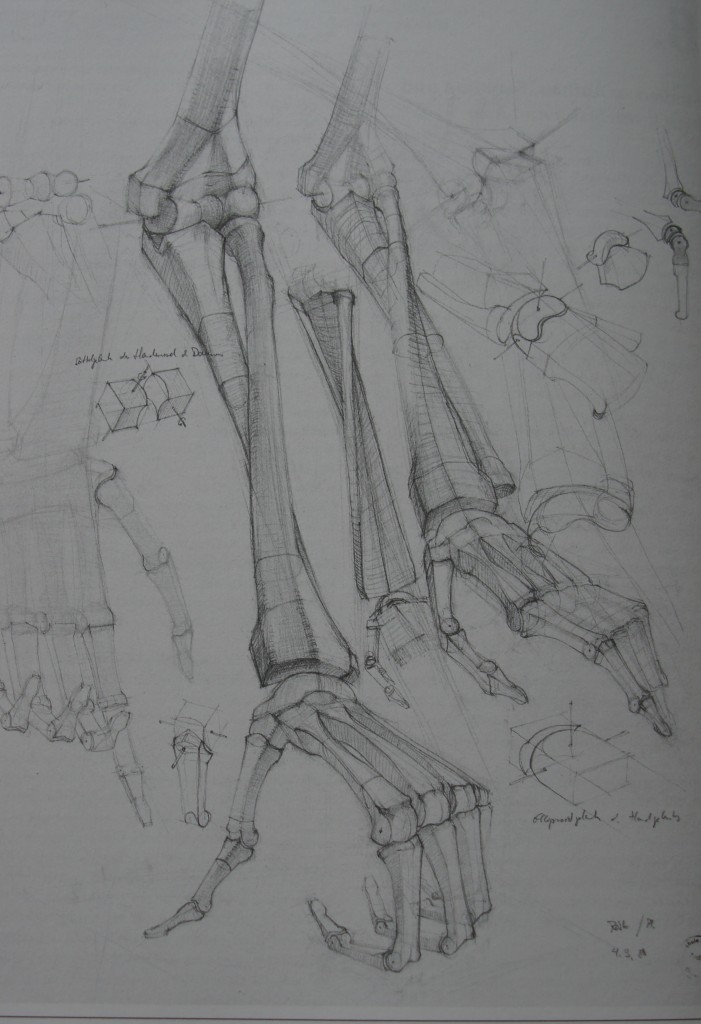
An anatomy drawing by a nameless second year student at art school
Many illustrious artists have wrestled with such subjects in the past. For sensitivity to the quality of bone, to the articulation of the joints and the movement in space I do not think this has ever been bettered. Talent still exists but not the ability to promote it; because we have left that in the hands of a band of deluded experts. We, who do not profit from their delusion recognize it to be a ludicrous scam from which we can only lose (through our pension funds as well as the emptiness of our museums of modern art.) The vast sums spent on encouraging establishment art discourages the eclipsed majority of artists.
Value in art is now dictated by the auctioneers and their gambling clients, who are probably unaware of the damage they are inflicting on civilization.
I published my discovery of Vermeer’s use of two mirrors in The Artist Magazine in Jan.1980. (British Version) under the title “Vermeer’s Method of Observation”. Looking at his The Artist in his Studio, sometimes called Ars Pictoria I asked myself the question “how did Vermeer see himself in back view?” Two mirrors seemed the obvious answer. When I carried out the experiment to see if this was true I realized that this was his general method and this, one of his last paintings, was a cryptic description of that method. Very many of his paintings contain an area of painted cloth in the left or right foreground where his own head would normally be reflected in the mirror on his easel. The cloth substitutes for his own reflection. The second mirror has to be bigger and placed about a meter and a half behind him.
More recently (July 2011) I placed two films on Youtube where Anne Shingleton demonstrates how helpful the system is. The chief benefit is the fact that the loss of light, particularly in a 17thC mirror which uses silver not mercury as the reflector, reduces the image down to a point where light can be matched with pigment. In July 2012 I put up a third film pointing out the improbability of his use of the camera obscura as a general method. In my view he was primarily interested in light, and to observe unfocused light he was obliged to use the camera obscura, as the eye refocuses automatically.
I am delighted to see that Tim Jenison has reopened the debate but am not convinced that his explanation of Vermeer’s unique genius in judging colour and tone is better than mine. Mine is simpler and accords with the evidence in many of the paintings (particularly Ars Pictoria). Probably most important it affords Vermeer a panoramic view of the subject and the reduced image of it after bouncing twice in 17thC mirrors thus allowing him to match light with pigment. This is the crux of Vermeer’s success in painting light.
More at www.nigelkonstam.com
Many of us feel the need to make things. As a sculptor I am something of an addict. I certainly exhibit withdrawal symptoms after a few days without this addiction. It is sad that machinery has speeded and perfected so much hand work that mankind has become very short of these soul soothing activities.
Cookery, music, dance, gardening and art have to stand in for all those useful crafts that we once did but are now done elsewhere or mechanically. Only thirty years ago there were little workshops in every village in Italy making shoes , garments, even hand made cars, most of them have disappeared leaving only the disappointed traces in creative humans with no outlet. This lack of opportunity will have to be addressed as western culture falls apart. Passive entertainment is no substitute.
Art has been recognized as a useful therapy and I am the last to wish to cut off this safety valve. The democratization of art has undoubtedly contributed to the sum total of human happiness. But it has had the negative effect of reducing our expectations from a work of art. It comes as no surprise that the average time spent looking at a work of art is now 20 seconds. I have often spent less time myself. Art has become a private matter. Abstract art does not lead to the sharing of vision in the way observed art used to do.
Artists in their great moments have been the helmsmen guiding human perception; they spend their lives looking and comparing what they make with what they see in nature. But their tentative perceptions have been drowned out by the loud-speakers of a mass-media, entirely subservient to a fashion for art so meaningless that it requires no response or study.
We need an elitist art again based on observation to keep the pathways to perception from being lost. There are very positive signs that the human race is very much less responsive to its own body language than it used to be. The long running demotion of Rembrandt’s vision by the “experts” is an outstanding symptom of this disorder. It could prove fatal to humanity in the long run.
‘Global warming’, is a grotesque understatement of the speed at which we approach distruction. It suggests we will be 2 or 3 degrees warmer and suffer a few inconvenient storms. The temperature on Venus is 900 degrees because the greenhouse gases insulate her so well that only little of the sun’s heat can escape.
We are adding to the greenhouse gases of this planet very rapidly.
There comes a ‘tipping-point’ at which the gases trapped in the Earth crust start to bubble out, from which point there is no imaginable return. Life on Earth will be extinguished and we are on our way to Venus.
WE ARE OBLIGED TO CHOOSE AN ALTERNATIVE TO GROWTH
This exhibition sets out to persuade us that Manet was as much influenced by Italian/Venetian art as by Velasquez and it makes a very good job of it. Manet made three journeys to Italy and in all made around 140 free copies from the masters. In this he was diligently following the normal artistic apprenticeship. The English short guide quotes “if art has had a history and continues to have one, it is thanks to the work of artists and also to their inspection of previous works and the way in which they appropriate them.” It does not tell us who said that originally but certainly a wise person. The present taste for novelty at all costs is a serious hiccup in the slow and unsteady evolution of seeing: ours is a period of regression, alas. This exhibition is a timely masterpiece aimed at the re-education of taste.
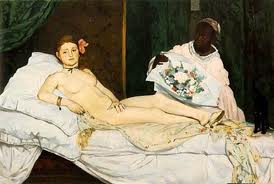
Olympia
The show has changed my perception of Manet in several ways. First, instead of the father figure of Impressionism as he is usually described, he was a late comer who refused their first invitation to join them. He made few genuinely Impressionist paintings late in life. Above all he was an eclectic who responded intelligently to many influences. He came nearest to Velasquez before he ever visited Spain: with his Olympia. Her slippers and the silks and satins of her boudoir are pure Velasquez and very beautifully painted. Her juxtaposition with Titian’s Venus of Urbino is interesting but only partially persuasive. Had the curators been able to put a late Velasquez princess beside them the story would have been more complete. Nor can I agree with the guide when it suggests “ sensuality is missing in the Olympia”. I believe Manet set out to give us a Parisian, 19th century version of the Titian but seen very much through the eyes of Velasquez.
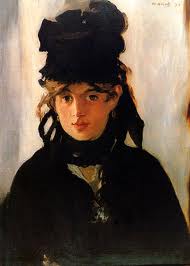
Berthe Morisot
His Spanish trip sees Manet dazzled by sunlight and Goya more than by Velasquez. While his beautiful late portrait of Berthe Morisot seems to owe more to Frans Hals than to Spain.
Thus, one of the most original and thoughtful artists of the 19th century was responding to a wide variety of artistic stimuli, last but not least, to Impressionism. A wonderful didactic exhibition – Venice, on till 18th August 2013.
The first thing to be said about this exhibition at The Palazzo Strozzi (till June 6th, after to go to the Louvre) is that it is not to be missed. It contains many masterpieces of sculptural observation from the richest ground: The Florentine Renaissance.
The exhibition sets out to show how much that springtime owed to Roman and French influence. A worthy aim, and it gets nearly halfway to the truth. The loan of the tiny, ivory “Timbal Madonna” (1260-70) from the Louvre allows us to compare the very human exchange between the French mother and child with the more symbolic treatment of the subject from Giovanni Pisano a generation later. It also allows us to understand how immediate was the flow of this new spirit into the hearts of Italian artists and patrons.
For those of us who believe that The “Duccio” Window was entirely the product of the stained-glass team from northern Europe who were then working in Assisi and from whom it was in fact commissioned (1288); it is quite clear that those masters were so far ahead of their Italian contemporaries at depicting the three dimensional world on a two dimensional surface that it took the Italians over 100 years to catch up. (This advanced knowledge from northern Europe is not discussed in the exhibition.)
The imports from Rome are also understated. Roman three dimensional geometry had a very strong influence on the vision of such masters as Desiderio da Settignano, Mino da Fiesole, and Rosselino, all well represented here; yet the three examples of Roman portraiture in the show look more towards Greece than to Rome and therefore fail entirely to make the looked for connection.
My main gripe against the scholars is my usual one of their strong bias in favour of classical references. They pay too much attention to the half remembered poses from antiquity and not enough to the intense and prolonged observation that is the driving force of the figurative arts at their best. The sequence of brilliant individualized portraits in this exhibition must surely leave us in no doubt that the observation of life was the chief motor for the “springtime”. The hunger for antique example found in both Ghiberti’s and Brunelleschi’s entries for the competition for the Baptistery doors, and well demonstrated in the catalogue was surely but a needed stepping-stone towards greater realism.
The catalogue (good value at 39€) is well-informed on this hunger for the example of antiquity among artists and patrons of the period but weak in the acknowledgement of direct observation from life, which must surely be at the root of these artists’ sustained enthusiasm.
For those artists who still worship the gods of observation Luca della Robbia’s Cantoria is a shrine for annual pilgrimage. They will be disappointed to find that this masterpiece is not represented by so much as a cast or photograph in the catalogue. In fact Luca, is represented by a string of mainly sentimental products of his terracotta workshop. To add injury to insult his two bronze putti (we must now learn to call them “spiritelli”) have been re-attributed to Donatello! contrary to the judgment of Pope Henessey and the word of Vasari. Indeed, it is hard to find a trace of Donatello’s treatment of this, his favorite subject, in either of them. Is it at all likely that having set up this comparison of the work of the two great masters that the confrontation would have been fudged by placing the putti of “Donatello” on the cantoria of Luca?
Re-attribution has become an art historical game that should be questioned with the utmost severity on every occasion. Modern connoisseurship has lost sight of the artist’s habitual patterns of thought which we used to call “form” and which are a much better guide to authorship than the minutiae of chisel marks, particularly in a case like this where the bronze is most likely to have been worked by artisans. (The re-attribution of Donatello’s Uzzano to Settignano seems to me equally misguided.)
Which brings me to my final gripe about the conception of the exhibition:- Verrocchio, who by any measure must have had the greatest influence on posterity: the summertime of the Renaissance, (also the strongest proponent of observation) is all but excluded, being only 25 at the terminal date of 1460. He is represented by one pedestrian portrait re-attributed to him but more likely by Rosselino. Let us hope the organizers are saving Verrocchio and his wonderful school for a second great exhibition.
In spite of these gripes, this is a feast not to be missed.
Monument to Elaine Morgan - tenacious proponent of the aquatic ape hypothesis
